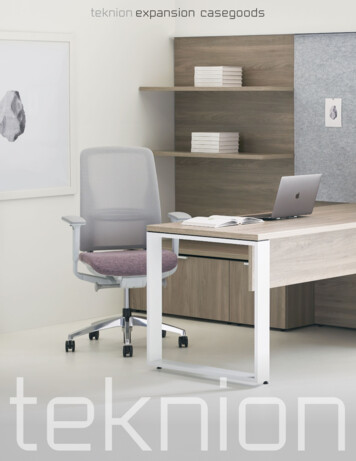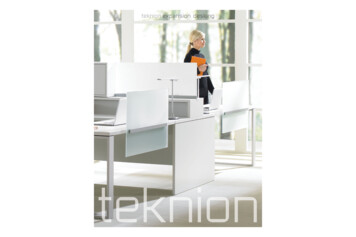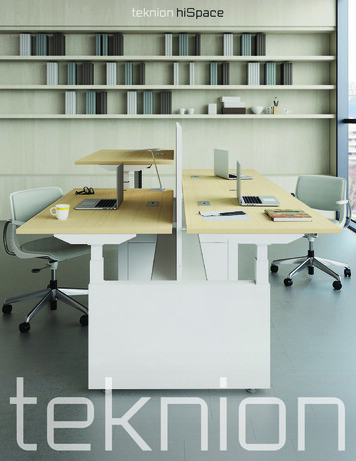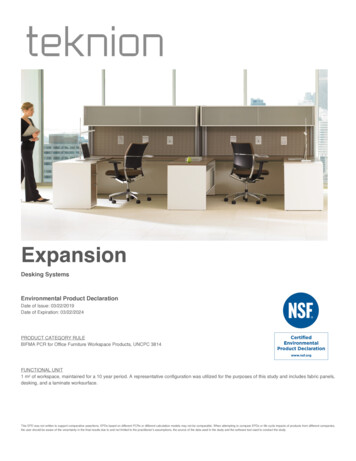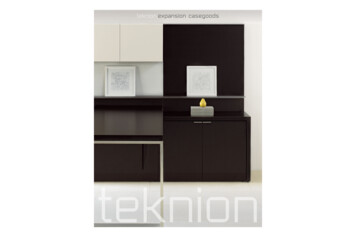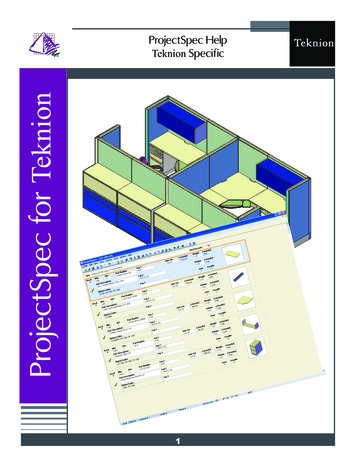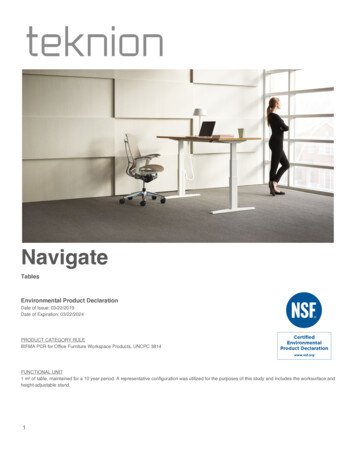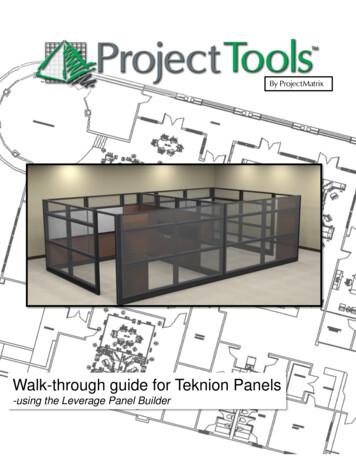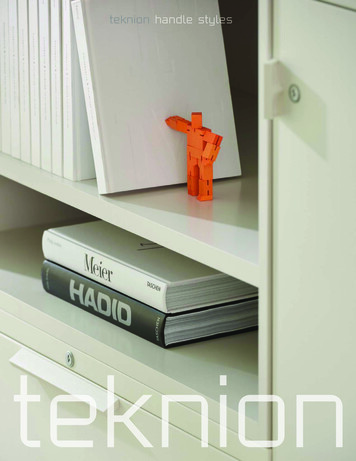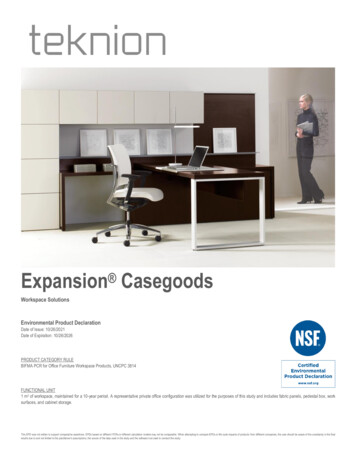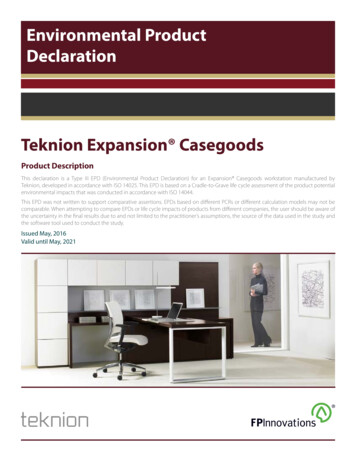
Transcription
Environmental ProductDeclarationTeknion Expansion CasegoodsProduct DescriptionThis declaration is a Type III EPD (Environmental Product Declaration) for an Expansion Casegoods workstation manufactured byTeknion, developed in accordance with ISO 14025. This EPD is based on a Cradle-to-Grave life cycle assessment of the product potentialenvironmental impacts that was conducted in accordance with ISO 14044.This EPD was not written to support comparative assertions. EPDs based on different PCRs or different calculation models may not becomparable. When attempting to compare EPDs or life cycle impacts of products from different companies, the user should be aware ofthe uncertainty in the final results due to and not limited to the practitioner’s assumptions, the source of the data used in the study andthe software tool used to conduct the study.Issued May, 2016Valid until May, 2021tekn·onFPlnnovation
EXPANSION CASEGOODSDESCRIPTION OF THE PRODUCTManufacturer informationTeknion is a leading international designer, manufacturer and marketerof mid- to high-end office systems and related furniture products.The different subcomponents of the Expansion Casegoods aremanufactured in one of the five (5) manufacturing plants from Teknion:Roy & Breton, RBTek, Teknion Laurier Station, Teknion Concept andTeknion Quebec, located in Quebec.Product descriptionThe Expansion Casegoods belongs to the desking products category.It is intended for one occupant at a time. The product consists ofthree (3) main parts: the hutch, the desk and the pedestal box, whichare also made of several components (ex: hutch frame, hutch back,hutch gable, etc.). These components are manufactured in Quebec(QC), in one of Teknion’s four (4) manufacturing plants.2
Table 1: Mass and dimensions of the 3 parts of the Expansion CasegoodsPartMass (kg)DimensionsLength (cm)Width (cm)Height (cm)Hutch68.81833894Desk116.418324474Pedestal box26.2464171The hutch includes a tower with 5 shelves and 1 storage unit with a storage volume of0.24 m3. The pedestal box includes 3 drawers. Tackboard panels are an optional productfeature. In addition to size, consumers can also choose certain materials. For example,the hutch door is available in glass or Low-Pressure Laminate (LPL). This product does notinclude any electrical components.Table 2: Materials of Expansion CasegoodsMaterialLPLAmount per UnitAmount per FUWeight Ratio115.4 kg25.9 kg54.6%Particleboard49.4 kg11.1 kg23.4%Steel23.0 kg5.2 kg10.9%Glass5.1 kg1.1 kg2.4%Backer3.9 kg0.9 kg1.8%HPL3.8 kg0.9 kg1.8%Aluminum3.0 kg0.7 kg1.4%Tentest2.9 kg0.6 kg1.4%Edge banding2.5 kg0.6 kg1.2%Zinc1.4 kg0.3 kg0.7%Powder coating0.5 kg0.1 kg0.2%Fabric0.4 kg0.1 kg0.2%TOTAL211.3 kg47.5 kg100.0%Note: 1 unit is equivalent to 4.46 functional units (FU).3
Packaging materialThe components are individually packed prior to shipping to the place of assembly. Table 3presents the aggregated amount of packaging materials for the 3 parts of the Expansion Casegoods.Table 3: Packaging materials - per partPlastic (kg)Cardboard (kg)Wood pallet (kg)0.351.025.50HutchDesk0.581.749.25Pedestal box0.130.392.10TOTAL1.063.1516.85Life Cycle AssessmentLife cycle assessment (LCA) is a rigorous study of inputs and outputs flows, over the entirelife of a product or process, and their associated environmental impacts. The present LCAis Cradle-to-Grave, meaning that it includes all impacts related to raw material acquisition,product manufacturing stage, distribution and use and end-of-life.The Cradle-to-Grave processes are presented by Figure 1.Figure 1: Cradle-to-grave process flow diagram of the Expansion CasegoodsExtraction and refiningof raw materialTransportationof raw material Production of semimanufactured goodsProduction to themanufacturer Manufacturingof componentsPackaging and stockingof final product½---DistributionUse phaseDisposalof the productDISTRIBUTIONUSEEND-OF-LIFEManufacturing forchemicals, auxilliarymaterialTransportation to themanufacturer-Treatment of wastegenerated by upsteammoduleIMATERIALACQUISITION4 Treatment of wastegenerated by coremodulePRODUCTIONI
Material acquisition:This includes extraction from nature, the production of semi-manufactured goods suchas particleboard, and their transportation to the gate of Teknion manufacturing plants.Waste produced during the extraction and production of semi-manufactured goods is alsoincluded in this step.Production:This step includes energy requirements (electricity, heat), water consumption, wasteproduction and environmental emissions related to the manufacturing and packagingof Expansion Casegoods components. It also includes the transportation of materialsbetween the different manufacturing plants.Distribution/use:Once the different parts have been packaged, they transit through the consolidation center,before being distributed all over the world, by truck or boat. The energy and materialsrequired for assembly are considered to be negligible. The use phase inventory contains nomaterials and / or energy, as no maintenance is required.End-of-life:At the end-of-life, the product is disposed of in municipal waste treatment facilities(incineration or landfill). The end-of-life stage also includes transportation from the place ofuse to the disposal facility.Functional unit1 m2 of Expansion Casegoods over 10 years, for one (1) occupant at a timeReference flowsOne unit of Expansion Casegoods is 4.46 m2. The product has a limited lifetime warranty anddemonstrates compliance with ANSI/BIFMA X5.5-2008. Therefore 0.224 units of Expansion Casegoods are necessary to fulfill the functional unit.Data sourcesThe LCA study collected primary data from Teknion for the year 2014 using a LCIquestionnaire. These data included the annual production volumes, the amount of rawmaterial, the losses related to these materials, the distances and transportation mode forthe raw material supply, the energy consumption, emissions to the environment, waterconsumption and waste production at the four (4) Teknion manufacturing plants as well asthe packaging materials.When primary data was not available, unit processes were selected from the ecoinventv3.1 database. When necessary, electricity grid mixes and transportation of unit processeshave been adapted to the appropriate specific contexts (Quebec, Canada, US or NorthAmerica).5
Cut-off rulesAccording to the PCR, if a mass flow or energy flow is less than 1% of the cumulative massor energy flow of the system, it may be excluded from system boundaries. However, thecumulative omitted mass or energy flow shall not exceed 5%.In the present study, all of the raw data obtained from Teknion concerning raw materials,energy and water use, air emissions, packaging, transportation and waste generated atTeknion manufacturing plants were included in the study. Therefore the cut-off was notapplied to any inventory data.AllocationData relative to energy consumption (electricity, heat), water consumption and wasteproduction were provided for each of the four (4) manufacturing plants as a total value, andnot specifically for the components. Therefore, allocation could not be avoided and massallocation was selected as the most suitable allocation method. Mass allocation was used todetermine the share of energy consumption, air emissions, water consumption and wasteproduction that could be assigned to each component of the Expansion Casegoods.ExclusionsFor this study, no data on the construction, maintenance or dismantling of the capital assets,daily transport of employees, office work, business trips, and other activity from Teknionemployees was included in the model. The model only takes into account processesassociated with infrastructures that are already included in the ecoinvent modules.Geographical coverageThis study is conducted in a Quebec context, as Teknion is based in the province of Quebec.Concerning secondary data, ecoinvent processes developed for Quebec were used inpriority. Otherwise, grid mixes were adapted consequently.6
LIFE CYCLE ASSESSMENT RESULTSEnvironmental Impact IndicatorsEnvironmental impact indicators, namely global warming, acidification, eutrophication,smog creation, and ozone depletion, have been calculated using the North Americanimpact assessment methodology TRACI v2.1 developed by the US EPA. The impact categoryindicators from TRACI are summarized in Table 4. Total primary energy consumption hasbeen determined using the Cumulative Energy Demand methodology v 1.09¹ as a basis.The consumption of fresh water has been determined using the “water intake” indicatorfrom the BEES v.4.05 impact assessment methodology.Table 4: Impact category indicators and reference substances of the TRACI methodologyImpact category indicatorsGlobal WarmingReference substance Descriptionkg CO2 eq. Contribution to global warming for all thesubstances listed by the IPCCAcidificationSO2 eq. Potential impact to increase acidity of soiland water systemsEutrophicationkg N eq. Potential fertilization of a surface waterwhere nutrient were previously scarceSmogOzonekg O3 eq. Potential impact on increasing smogkg CFC-11 eq. Potential impact on stratospheric ozonedepletion¹ The method to calculate Cumulative Energy Demand (CED) is based on the method first published byecoinvent version 1.01 and expanded by PRé Consultants for energy resources available in the SimaProdatabase. (Frischknecht et al. 2003).Treatment of biogenic carbonCarbon dioxide emissions released from the combustion of woody biomass duringproduction are considered as climate neutral. This does not apply to other emissionsassociated with wood combustion, such as methane or nitrogen oxides, that are consideredto have a global warming potential. Biogenic carbon emissions are therefore calculatedusing the Greenhouse gas protocol methodology and are reported separately.7
Cradle-to-grave impact assessment resultsEnvironmental impacts and life cycle inventory parameters related to 1 m2 Expansion Casegoods are presented in Table 5.Table 5: Environmental Impacts, Energy consumption and Water consumption of theExpansion CasegoodsImpact category indicatorPer FunctionalUnit (1 m2)UnitPer Expansion Casegoods unit(4.46 m2)Global Warming potential 100 yearskg CO2 eq44399Global Warming potential 20 yearskg CO2 eq536120kg CO2 biogenic15535kg SO2 eq2.80.6kg N eq2.20.5Biogenic carbon emissionsAcidification potentialEutrophication potentialSmog creation potentialOzone depletion potentialkg O2 eq38.58.6kg CFC-11 eq6.06E-051.35E-05MJ7 1951 613Total primary energy consumptionNon-renewable EnergyRenewable EnergyMJ5 0961 142TOTALMJ12 2912 758kg11 5312 585Water consumptionFresh water8
Contribution of life cycle stagesThe breakdown of the impacts scores for the different Expansion Casegoods life cyclestages is presented in Table 6. Raw material acquisition is responsible for more than 60% ofthe impacts in four (4) impact categories. Raw material acquisition is also the lifecycle stagethat consumes the most energy and water ( 70%).Table 6: Contribution of the life cycle stages to the environmental impacts of the Expansion ributionand Use4.End-of-lifeGlobal Warming Potentialkg CO2 eq443.0326.042.163.712.0Acidification Potentialkg SO2 eq2.802.180.160.410.03Eutrophication Potentialkg N eq2.240.990.080.071.10Smog creation Potentialkg O3 eq38.5025.002.4010.400.64kg CFC-11 wable EnergyMJ7,1955,2498451,03566Renewable ,52230774EnvironmentalIndicatorOzone Depletion Potential9
Other configurationsExpansion Casegoods can be purchased in various configurations. The present EPD is basedon the most representative configuration in terms of dimensions and materials.Clients have the choice of whether or not to include the hutch and pedestal box. Table 7presents the contribution of the three main components (the hutch, desk and pedestal box)to the environmental impacts of the raw materials, production, distribution and end-of-lifestages. This allows users to take into account only the elements present in this configuration.Table 7: Contribution of the 3 parts of the Expansion Casegoods to the impact of thedifferent life cycle kPedestal boxHutchDeskPedestal boxGlobal Warming Potentialkg CO2 eq42%48%10%51%42%8%Acidification Potentialkg SO2 eq44%47%9%44%46%10%Eutrophication Potentialkg N eq46%43%11%44%46%10%Smog creation Potentialkg O3 eq38%53%9%43%47%10%kg CFC-11 eq37%54%9%57%37%7%Non-Renewable EnergyMJ36%54%10%43%49%8%Renewable 3%10%Ozone Depletion LifeUnitHutchDeskPedestal boxHutchDeskPedestal boxGlobal Warming Potentialkg CO2 eq30%58%12%27%61%12%Acidification Potentialkg SO2 eq30%58%12%33%54%13%Eutrophication Potentialkg N eq30%58%12%25%63%12%Smog creation Potentialkg O3 eq30%58%12%32%55%13%kg CFC-11 eq30%58%12%35%52%13%Non-Renewable EnergyMJ30%58%12%36%51%13%Renewable 52%13%Ozone Depletion Potential10Raw materials
The Expansion Casegoods can also be purchased in different sizes. When the size of thepurchased product differs from the one presented in this EPD, the user has the possibility tocalculate the mass ratio of his product over the product presented here (see Table 1) andthen apply this ratio to the different impact scores, as these impacts are strongly correlatedto the amount of materials contained in the different parts. This is also true for impactsrelated to production, as mass allocation was used to determine the energy inputs.Other configurations may include: The replacement of the hutch glass doors by LPL doors; and/or The presence/absence of tackable elements.These two configurations did not lead to a variation superior to 10% in every impactcategory. Therefore they are covered by the present EPD. Similarly, this EPD covers everycolor finishes of the Expansion Casegoods product range.Additional environmental informationTeknion is certified ISO 14001, and all of their products are certified GREENGUARD andDesign for Environment (DfE). All of Teknion’s productshave been Level certified in accordance to the BIFMA e3 sustainability standard. Workstations made with Forest Stewardship Council (FSC) wood can be made upon request.11
ReferencesBare, J. C. and T. P. Gloria (2008). Environmental impact assessment taxonomyproviding comprehensive coverage of midpoints, endpoints, damages,and areas of protection. Journal of Cleaner Production 16: 1021-1035.BIFMA, PCR for Office Furniture Workspace Products: UNCPC 3814Ellio (2015). Life cycle assessment - Expansion Casegoods, Teknion, 48 ppFrischknecht, R., N. Jungbluth et al. (2003). Implementation of Life Cycle ImpactAssessment Methods. Final report ecoinvent 2000, Swiss Centre for LCI.Dübendorf, CH, www.ecoinvent.orgISO (2006a). ISO 14025:2006 - Environmental labels and declarations.Type III environmental declarations -- Principles and procedures.ISO (2006b). ISO 14044. Environmental management -- Life cycle assessment -Requirements and guidelines. Geneva, Switzerland, International Organisationfor Standardisation: 46.Statistics Canada (2012). Waste management in Canada, in Human Activityand the Environment. Catalogue no. 16-201-X. Minister of Industry. Ottawa, ON,Canada. 46ppUS EPA, 2012. Municipal Solid Waste Generation, Recycling, and Disposal in theUnited States: Facts and Figures for 2012About this EPDThe LCA and the EPD produced by Vertima and Ellio with guidance from FPInnovations.PROGRAM OPERATOR:EPD OWNER:FPInnovations2665 East MallVancouver, BC V6T 1W51 (604) 224-3221www.fpinnovations.caTeknion1150 Flint RoadToronto, ON M3J 2J5 Canada1 (416) 661-3370www.teknion.comFUNCTIONAL UNIT (FU)1 m² of Expansion Casegoods over10 years, for one occupant at a timeSURFACE4.46 m² per unitSERVICE LIFE10 yearsELECTRICAL COMPONENTSNonePCR REVIEW WASCONDUCTED BY:Thomas P. Gloria, Ph. D.Industrial Ecology Consultants35 Bracebridge Rd.Newton, MA L FEATURES AND FUNCTIONSNoneThis declaration was independentlyverified in accordance withISO 14025 byALTERNATE CONFIGURATIONSThis EPD covers every color finishes of the Expansion Casegoods product range.This EPD also covers the following 2 scenarios: INTERNAL- The replacement of the hutch glass doors by Low Pressure Laminates (LPL) doors.- The presence/absence of tackable elements.Expansion Casegoods technical sheet and explanatory materials on thebackground LCA can be found online at www.teknion.com12REFERENCE PCRProduct Category Rules (PCR)for preparing an EnvironmentalProduct Declaration for OfficeFurniture Workspace Products,BIFMA, August 2015.EXTERNALLal MahalleFPInnovations, 2665 East Mall,Vancouver, BC V6T 1W5Issued May, 2016Valid until May, 2021
Teknion is a leading international designer, manufacturer and marketer of mid- to high-end office systems and related furniture products. The different subcomponents of the Expansion Casegoods are manufactured in one of the five (5) manufacturing plants from Teknion: Roy & Breton, RBTek, Teknion Laurier Station, Teknion Concept and
